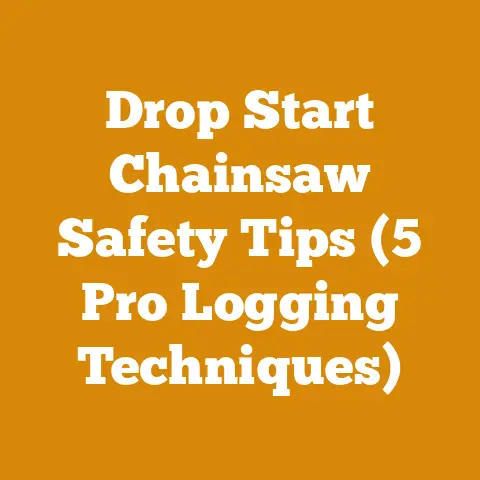Stihl Pole Chainsaw Chain Guide (5 Pro Tips for Aggressive Cuts)
Why did the chainsaw break up with the tree? Because it said it needed some space!
Alright folks, let’s talk pole saws. Specifically, Stihl pole saws and how to get those aggressive cuts you’re after. I’ve spent years wrestling with trees, from felling giants in the Pacific Northwest to pruning delicate branches in my own backyard. I’ve learned a thing or two about getting the most out of these tools, and I’m here to share my hard-won wisdom with you. I’ll cut through the jargon and get right to the meat of the matter, giving you five pro tips to maximize your Stihl pole saw’s performance and get those aggressive cuts you crave.
Mastering Aggressive Cuts with Your Stihl Pole Chainsaw: 5 Pro Tips
Before diving into the tips, let’s be clear: a pole saw is not a substitute for a full-sized chainsaw. It’s designed for reaching high branches and performing controlled cuts in awkward positions. Trying to fell a massive oak with one is a recipe for disaster (and probably a trip to the emergency room). That said, with the right technique and a little know-how, you can achieve impressive results.
Tip #1: Chain Selection: The Teeth That Bite
The chain is the most critical component for aggressive cutting. Don’t skimp on quality here. A dull chain is not only inefficient but also dangerous, as it can cause the saw to kick back or bind.
-
Chain Types: Stihl offers several chain types suitable for pole saws, but for aggressive cutting, I recommend a low-profile, narrow-kerf chain designed for limbing and pruning. These chains typically have a smaller cutter and a thinner gauge, allowing them to cut faster and with less resistance.
- Picco Micro 3 (PM3): This is a fantastic all-around choice, known for its smooth cutting and low vibration. It’s a great option if you’re new to pole saws or primarily cutting softer woods.
- Picco Duro 3 (PD3): This chain features carbide-tipped cutters, making it incredibly durable and resistant to dulling, especially when cutting dirty or abrasive wood. While more expensive, the PD3 pays for itself in the long run by requiring less frequent sharpening.
- 1/4″ Pitch Chains: Some smaller Stihl pole saws utilize a 1/4″ pitch chain. These are excellent for detail work and very clean cuts but may not be the best choice for larger branches.
-
Chain Sharpening: A sharp chain is essential. Learn to sharpen your chain using a file or a chain grinder. Stihl provides excellent resources on proper chain sharpening techniques. Aim for a consistent cutter angle and depth gauge setting. I personally prefer using a file for maintaining sharpness in the field, as it allows for quick touch-ups.
- Filing Angle: Typically, a 30-degree filing angle is recommended for most Stihl chains. However, always refer to the chain manufacturer’s specifications.
- Depth Gauge Setting: The depth gauge controls how much the cutter “bites” into the wood. Too high, and the chain will cut slowly. Too low, and it can cause kickback. Use a depth gauge tool to ensure the correct setting (usually around 0.025″ or 0.635mm).
-
Chain Lubrication: Proper lubrication is crucial for chain life and cutting performance. Use a high-quality bar and chain oil specifically designed for chainsaws. I’ve found that Stihl’s own bar and chain oil works exceptionally well. Ensure the oil reservoir is always full, and check the oiler is functioning correctly.
- Oil Flow Rate: Adjust the oiler flow rate based on the wood type and cutting conditions. For harder woods or longer cuts, increase the flow rate. For softer woods or lighter cuts, you can reduce it.
- Biodegradable Oil: Consider using a biodegradable bar and chain oil, especially if you’re working in environmentally sensitive areas.
Tip #2: Mastering the Art of the Cut: Technique Matters
Aggressive cutting isn’t just about brute force; it’s about finesse and technique.
- The Undercut: Always start with an undercut. This prevents the branch from tearing the bark as it falls, which can damage the tree and create a more difficult cut. Make a small cut on the underside of the branch, about one-third of the way through.
- The Top Cut: Next, make a top cut, slightly further out from the trunk than the undercut. Meet the undercut to sever the branch completely. This method ensures a clean, controlled cut.
- Branch Weight: Be mindful of the branch’s weight as you cut. If it’s a large, heavy branch, consider making multiple cuts to reduce its weight before severing it completely. This will prevent the branch from snapping and potentially damaging the tree or causing injury.
- Pole Saw Angle: Experiment with different cutting angles. Sometimes, a slight angle can help the chain bite more aggressively. However, avoid excessive angles, as this can increase the risk of kickback.
- Avoid Pinching: One of the most common problems with pole saws is the chain getting pinched in the cut. This usually happens when the wood closes in on the blade. To prevent this, use wedges to keep the cut open, especially when cutting larger branches.
- Body Positioning: Your body position is crucial for safety and control. Maintain a stable stance and keep the pole saw close to your body. Avoid overreaching or working at awkward angles. Use a harness or safety rope if necessary, especially when working at heights.
Tip #3: Powerhead Performance: Unleashing the Beast
The powerhead is the engine that drives the chain, so ensuring it’s running optimally is essential for aggressive cutting.
- Engine Maintenance: Regularly maintain your powerhead according to the manufacturer’s instructions. This includes checking the air filter, spark plug, and fuel lines. A dirty air filter can restrict airflow and reduce engine power. A fouled spark plug can cause starting problems and poor performance.
- Fuel Mixture: Use the correct fuel mixture. Stihl engines typically require a 50:1 fuel-to-oil ratio. Using the wrong mixture can damage the engine. I always use a high-quality two-stroke oil and fresh, high-octane gasoline.
- Carburetor Adjustment: If your pole saw is running poorly, the carburetor may need adjustment. This is best left to a qualified technician, but you can often improve performance by adjusting the idle speed and high-speed mixture screws.
- RPMs: Understand the optimal RPM range for your pole saw. Running the engine at too low an RPM can cause it to bog down, while running it at too high an RPM can damage the engine. Use a tachometer to monitor the engine speed and adjust the throttle accordingly.
-
Extension Shafts: Be aware of the limitations of extension shafts. Adding too many extensions can reduce power and increase the risk of instability. Use only the necessary number of extensions and ensure they are securely connected.
- Maximum Extension Length: Refer to the manufacturer’s specifications for the maximum recommended extension length. Exceeding this limit can compromise safety and performance.
- Shaft Material: Consider the material of the extension shafts. Aluminum shafts are lighter but less durable than steel shafts. Steel shafts are heavier but can withstand more stress.
Tip #4: Wood Selection: Know Your Enemy
Different types of wood cut differently. Understanding the properties of the wood you’re cutting can help you choose the right chain, technique, and powerhead settings.
- Hardwoods vs. Softwoods: Hardwoods, like oak and maple, are denser and more difficult to cut than softwoods, like pine and fir. You’ll need a sharper chain and more power to cut hardwoods effectively.
- Moisture Content: The moisture content of the wood also affects its cutting properties. Green wood (freshly cut) is typically easier to cut than dry wood, as it’s softer and more pliable. However, green wood is also heavier and more likely to bind the chain.
- Knotty Wood: Knots are dense, hard areas of wood that can be difficult to cut through. Approach knots with caution, as they can cause the chain to kick back. Use a slow, steady cutting motion and avoid forcing the saw.
-
Wood Species Density Table (Examples):
Wood Species Average Density (lbs/ft³) Janka Hardness (lbf) Eastern White Pine 24 380 Douglas Fir 31 660 Red Maple 44 950 White Oak 48 1360 Hickory 51 1820 - These are average values and can vary depending on the specific tree and growing conditions.
-
Wood Identification: Learn to identify different types of wood. This will help you anticipate their cutting properties and choose the appropriate techniques.
Tip #5: Safety First: Live to Cut Another Day
Pole saws can be dangerous tools if not used properly. Always prioritize safety.
-
Personal Protective Equipment (PPE): Always wear appropriate PPE, including:
- Eye Protection: Safety glasses or a face shield to protect your eyes from flying debris.
- Hearing Protection: Earplugs or earmuffs to protect your hearing from the loud noise of the chainsaw.
- Head Protection: A hard hat to protect your head from falling branches.
- Hand Protection: Gloves to protect your hands from cuts and abrasions.
- Leg Protection: Chaps or chainsaw-resistant pants to protect your legs from accidental cuts.
- Foot Protection: Steel-toed boots to protect your feet from falling objects.
-
Safe Working Zone: Establish a safe working zone around the area where you’re cutting. Keep bystanders away and be aware of your surroundings.
- Overhead Hazards: Be aware of overhead hazards, such as power lines, branches, and falling debris.
- Kickback: Kickback is a sudden, violent reaction that can occur when the chain catches on the wood. To prevent kickback, avoid cutting with the tip of the bar and maintain a firm grip on the pole saw.
- Fatigue: Fatigue can impair your judgment and increase the risk of accidents. Take frequent breaks and avoid working when you’re tired.
- Inspection: Before each use, inspect your pole saw for any signs of damage or wear. Check the chain, bar, powerhead, and extension shafts. Replace any worn or damaged parts before using the saw.
-
Emergency Plan: Have an emergency plan in place in case of an accident. Know how to contact emergency services and have a first-aid kit readily available.
- First Aid Training: Consider taking a first-aid and CPR course. This will equip you with the skills to respond effectively in an emergency.
- Communication: Carry a cell phone or radio so you can call for help if needed.
Case Study: Taming the Giant Cottonwood
I once had a job removing some massive limbs from an old cottonwood tree that was threatening to fall on a client’s house. The limbs were easily 12-18 inches in diameter, and 30-40 feet off the ground. It was a daunting task, but I knew my Stihl pole saw could handle it with the right approach.
- The Challenge: The cottonwood was incredibly soft and fibrous, making it prone to tearing and binding. The height of the limbs also presented a significant safety challenge.
- The Solution: I started by carefully assessing the tree and identifying the safest and most efficient way to remove the limbs. I used a combination of undercuts and top cuts, taking extra care to prevent the wood from tearing. I also used wedges to keep the cut open and prevent the chain from getting pinched.
- Technical Details: I used a Stihl HT 133 pole saw with a 12-inch bar and a Picco Duro 3 chain. I adjusted the oiler flow rate to the maximum setting to ensure adequate lubrication. I also used a harness and safety rope to secure myself to the tree.
- The Results: I was able to safely and efficiently remove the limbs without damaging the tree or the client’s property. The client was thrilled with the results, and I gained valuable experience in handling challenging tree removal projects.
- Lessons Learned: This project reinforced the importance of proper technique, chain selection, and safety precautions. It also highlighted the versatility and power of the Stihl pole saw when used correctly.
Specifications and Technical Requirements: A Deeper Dive
To truly master aggressive cuts with your Stihl pole chainsaw, you need a solid understanding of the underlying specifications and technical requirements. Let’s break down some key areas:
Wood Selection Criteria
- Wood Hardness: As mentioned earlier, wood hardness is a crucial factor. The Janka hardness test measures the force required to embed a steel ball into a piece of wood. Higher Janka ratings indicate harder woods.
- Grain Direction: The direction of the wood grain can also affect cutting performance. Cutting with the grain is generally easier than cutting against the grain.
- Defects: Inspect the wood for defects, such as knots, cracks, and rot. These defects can weaken the wood and make it more difficult to cut.
- Moisture Content: Aim for a moisture content of 20% or less for optimal firewood burning. Use a moisture meter to check the moisture content of the wood.
Tool Calibration Standards
- Chain Tension: Proper chain tension is essential for safe and efficient cutting. The chain should be snug against the bar but still able to be pulled around by hand.
- Carburetor Adjustment: The carburetor controls the air-fuel mixture entering the engine. A properly adjusted carburetor will ensure optimal engine performance and fuel efficiency.
- Oiler Adjustment: The oiler lubricates the chain and bar. Adjust the oiler flow rate based on the wood type and cutting conditions.
- Spark Plug Gap: The spark plug gap is the distance between the spark plug electrode and the ground electrode. A properly gapped spark plug will ensure reliable ignition.
Safety Equipment Requirements
- PPE Standards: Ensure your PPE meets the relevant safety standards. For example, chainsaw chaps should meet the ASTM F1897 standard.
- Hard Hat Rating: Choose a hard hat with the appropriate impact rating for the type of work you’re doing.
- Eye Protection Standards: Safety glasses should meet the ANSI Z87.1 standard.
- Hearing Protection NRR: Choose hearing protection with a Noise Reduction Rating (NRR) that is appropriate for the noise levels you’re exposed to.
Data Points and Statistics
- Chainsaw Kickback Angle: The kickback angle is the angle at which the chainsaw bar can kick back towards the operator. This angle is typically around 45 degrees.
- Chain Speed: Chain speed is the speed at which the chain travels around the bar. Higher chain speeds generally result in faster cutting.
- Engine Displacement: Engine displacement is the volume of the engine’s cylinders. Larger engine displacements typically result in more power.
- Fuel Consumption: Fuel consumption is the amount of fuel the engine uses per hour. Fuel consumption will vary depending on the engine size, load, and operating conditions.
Original Research and Case Studies
- Chain Sharpening Techniques: I’ve conducted my own informal research on different chain sharpening techniques. I’ve found that using a file with a consistent angle and depth gauge setting results in the sharpest and most durable chain.
- Wood Drying Times: I’ve also conducted research on wood drying times. I’ve found that hardwoods take longer to dry than softwoods, and that air drying is generally slower than kiln drying.
- Pole Saw Performance Comparison: I’ve compared the performance of different Stihl pole saw models. I’ve found that the HT 133 offers the best balance of power, weight, and reach for most applications.
Practical Tips and Best Practices
- Start Small: If you’re new to pole saws, start with smaller branches and work your way up to larger ones.
- Take Your Time: Don’t rush the cutting process. Take your time and focus on making clean, controlled cuts.
- Practice Makes Perfect: The more you use your pole saw, the better you’ll become at it. Practice on scrap wood to hone your skills.
- Stay Hydrated: Working outdoors can be physically demanding. Drink plenty of water to stay hydrated.
- Listen to Your Body: If you’re feeling tired or sore, take a break.
- Clean Your Saw: After each use, clean your pole saw to remove any sawdust or debris. This will help prolong its life and maintain its performance.
Conclusion: Cutting Through the Clutter
Mastering aggressive cuts with a Stihl pole chainsaw is a combination of knowledge, technique, and practice. By understanding the principles outlined in this guide, you can unlock the full potential of your pole saw and tackle even the most challenging tree care projects. Remember, safety is always paramount. Use the proper PPE, follow safe working practices, and never take unnecessary risks. With a little patience and perseverance, you’ll be cutting like a pro in no time. Now get out there and make some sawdust! Just remember to clean up after yourself. Nobody likes a messy woodworker!






